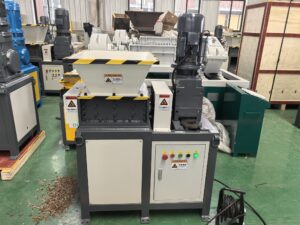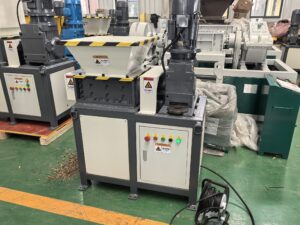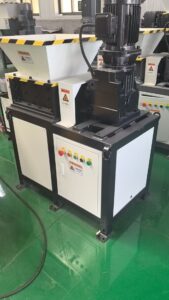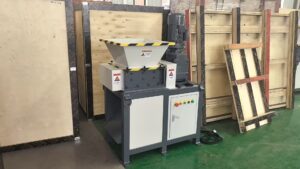In the world of waste management and recycling, efficiency and simplicity are often just as important as brute force. Enter the Small Single-Motor Shredder — a compact yet highly effective solution for small-scale shredding needs. Whether you’re dealing with plastic waste, e-waste, biomass, or industrial scraps, this versatile machine packs surprising power in a small footprint. In this article, we will explore everything you need to know about small single-motor shredders: how they work, what materials they handle, why they’re valuable, and what makes them a smart investment for startups and industrial workshops alike.
🔧 What is a Small Single-Motor Shredder?


A single-motor shredder is a type of low-speed, high-torque industrial shredder powered by one motor, typically coupled with a gear reducer. Unlike dual-shaft or dual-motor shredders, it operates with a simpler mechanical structure but delivers robust performance suitable for many materials.
The “small” classification refers to its compact size, moderate shredding capacity, and ease of integration into tight spaces — ideal for workshops, small recycling businesses, laboratories, or on-site material pre-processing.
🧱 Materials It Can Shred

Despite its size, a small single-motor shredder is surprisingly versatile. It is capable of shredding:
-
Plastics (ABS, PVC, PE, PP, PET, etc.)
-
Rubber pieces and foam
-
Wires and cables
-
Small circuit boards
-
Cardboard and paper
-
Light metal scraps (e.g., aluminum cans)
-
Agricultural waste (e.g., corn stalks, palm fibers)
-
Wood scraps or MDF trimmings
-
Household waste packaging
⚠️ Note: While this shredder handles a variety of materials, it is not suitable for high-hardness metals or entire car parts. For such applications, a double-shaft shredder or heavy-duty model is recommended.
🛠️ Key Features & Technical Specifications
Here are some typical features and specs found in a high-quality small single-motor shredder:
| Feature | Specification |
|---|---|
| Motor Power | 5.5kW – 15kW (depending on model) |
| Blades | High-strength alloy steel |
| Blade Shaft | Single shaft with push ram (optional) |
| Output Size | 10–80mm (adjustable with screen) |
| Capacity | 300 – 1500 kg/h |
| Hopper Size | Customizable |
| Control System | PLC-based with overload protection |
| Transmission | Gear reducer (strong torque output) |
| Dimensions | Compact (e.g., 1.2m x 0.8m x 1.5m) |
Many machines are equipped with easy-to-maintain blade assemblies, safety interlocks, and low-noise design, making them user-friendly and durable.
💡 Why Choose a Single-Motor Shredder?
1. Compact Size, Big Output
Designed for limited space environments, these shredders are perfect for startups, small factories, and mobile processing setups.
2. Energy Efficiency
With only one motor, power consumption is reduced, and operational costs are significantly lower compared to dual-shaft machines.
3. Lower Maintenance
Fewer moving parts = less wear and tear. Blade changes and gearbox servicing are simpler and faster.
4. Flexible Applications
From recycling labs to e-waste processors, small single-motor shredders are used across dozens of industries. They’re even used in universities for material testing.
5. Budget-Friendly
Lower cost makes it an ideal entry-level investment for businesses looking to automate waste handling or build a local recycling line.
📦 Typical Use Cases

-
Plastic recycling: Shred injection molding runners, PET bottles, and film waste.
-
Electronics recycling: Pre-shred PCB boards, cables, and small appliances.
-
Packaging recycling: Cardboard, plastic trays, bubble wrap.
-
Wood processing: MDF offcuts, furniture scraps.
-
Agricultural by-product handling: Corn stalks, coconut shells.
-
Food industry: Shred packaging waste before incineration or disposal.
✅ Optional Add-Ons & Customization
A good shredder manufacturer often provides customization options, such as:
-
Screen mesh sizes (to control output size)
-
Hydraulic push ram (to feed materials more efficiently)
-
Dust collection ports
-
Soundproof housing
-
Conveyor belts for input/output
-
Automatic reverse protection system
These features enhance safety, reduce downtime, and help you integrate the machine into an existing production line.
📊 Return on Investment (ROI)
Investing in a small single-motor shredder often brings visible ROI in less than 12 months. Here’s how:
-
✅ Cut down on manual labor cost for waste handling
-
✅ Reduce transportation costs by shrinking material volume
-
✅ Prepare materials for higher-value recycling or resale
-
✅ Comply with local environmental disposal regulations
🧰 Maintenance Tips
To keep your small shredder running smoothly:
-
Lubricate gear reducer and bearings regularly
-
Clean the chamber and remove residues
-
Inspect blades weekly and rotate/sharpen when needed
-
Avoid overloading the machine
-
Ensure proper ventilation to avoid overheating
With regular maintenance, the shredder can last 5-8 years or more under normal usage conditions.
❓ Frequently Asked Questions
Q1: Can it shred metal?
A1: Only soft/light metals like aluminum cans or foil. For thick or hardened metal, a dual-shaft shredder is recommended.
Q2: Is it noisy?
A2: Operating noise is generally between 65–80 dB. You can add sound insulation if working in a quiet area.
Q3: Is this machine safe?
A3: Yes, it typically comes with overload, reverse, and emergency stop systems. Follow operational instructions to avoid accidents.
Q4: Can I use it continuously?
A4: While it can run long hours, it’s best to allow for cooling breaks during high-volume operation to extend motor life.
📍 Conclusion: A Small Machine with Big Potential
The Small Single-Motor Shredder is a compact, affordable, and surprisingly powerful solution for a wide variety of shredding tasks. From recycling facilities to lab-scale operations, it offers flexibility, cost-efficiency, and simplicity — all in a space-saving design.
If you’re just starting a recycling business, looking to upgrade your workshop’s waste handling, or want to add a material preparation step before granulation, this shredder could be the perfect fit.
